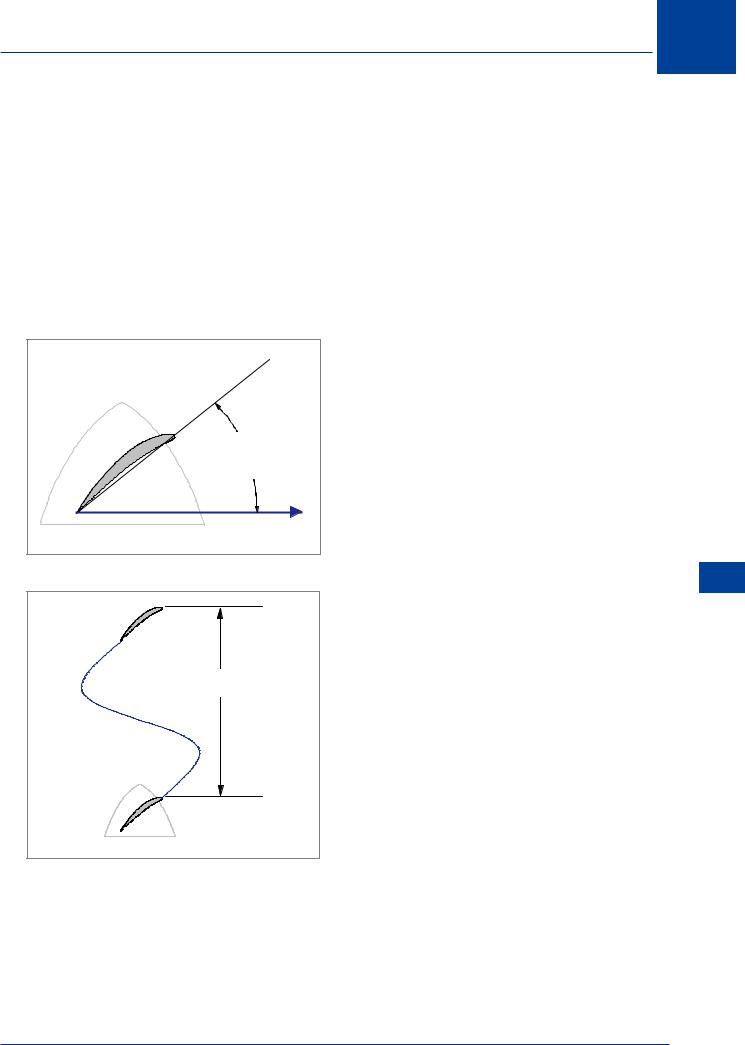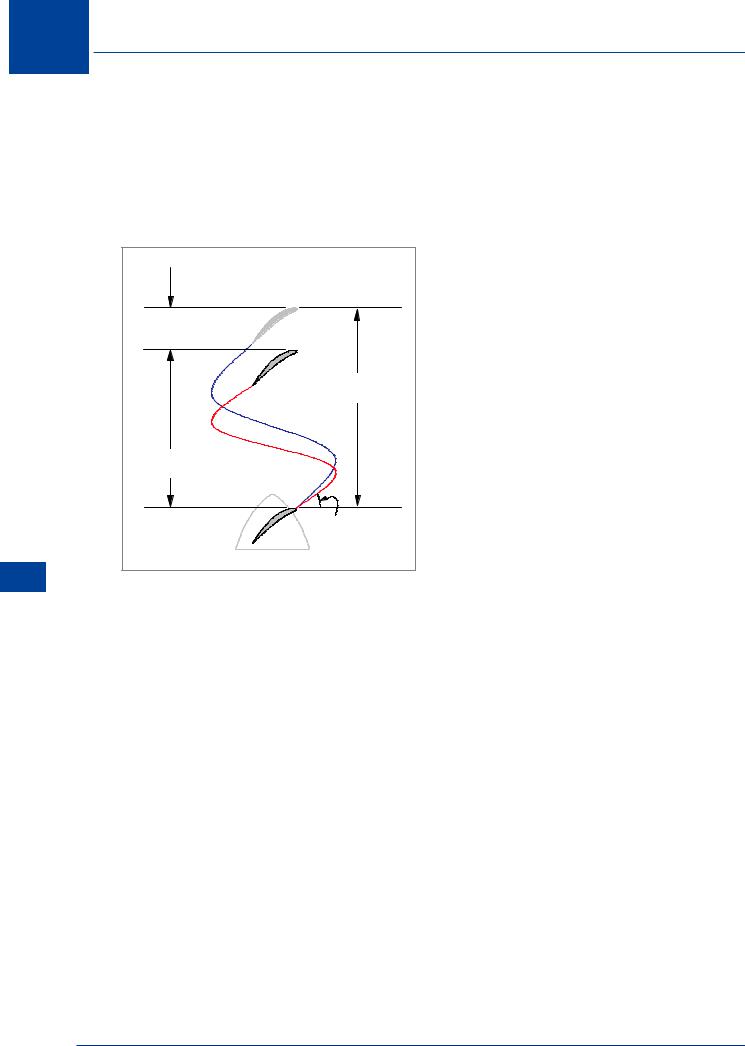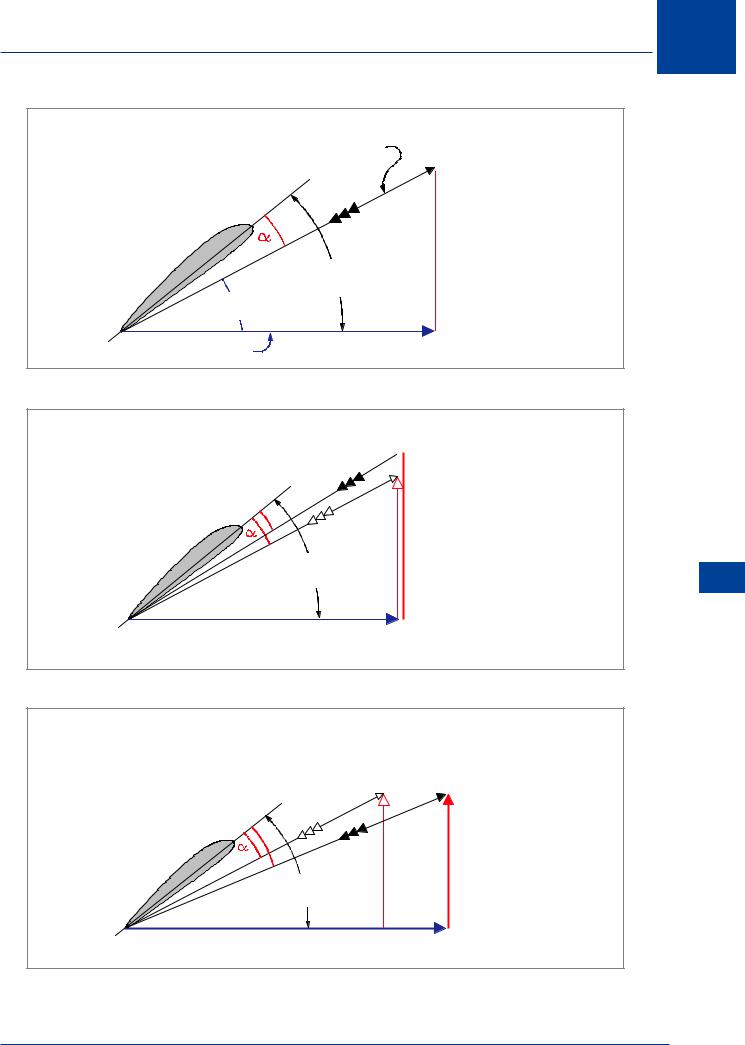
- •Textbook Series
- •Contents
- •1 Overview and Definitions
- •Overview
- •General Definitions
- •Glossary
- •List of Symbols
- •Greek Symbols
- •Others
- •Self-assessment Questions
- •Answers
- •2 The Atmosphere
- •Introduction
- •The Physical Properties of Air
- •Static Pressure
- •Temperature
- •Air Density
- •International Standard Atmosphere (ISA)
- •Dynamic Pressure
- •Key Facts
- •Measuring Dynamic Pressure
- •Relationships between Airspeeds
- •Airspeed
- •Errors and Corrections
- •V Speeds
- •Summary
- •Questions
- •Answers
- •3 Basic Aerodynamic Theory
- •The Principle of Continuity
- •Bernoulli’s Theorem
- •Streamlines and the Streamtube
- •Summary
- •Questions
- •Answers
- •4 Subsonic Airflow
- •Aerofoil Terminology
- •Basics about Airflow
- •Two Dimensional Airflow
- •Summary
- •Questions
- •Answers
- •5 Lift
- •Aerodynamic Force Coefficient
- •The Basic Lift Equation
- •Review:
- •The Lift Curve
- •Interpretation of the Lift Curve
- •Density Altitude
- •Aerofoil Section Lift Characteristics
- •Introduction to Drag Characteristics
- •Lift/Drag Ratio
- •Effect of Aircraft Weight on Minimum Flight Speed
- •Condition of the Surface
- •Flight at High Lift Conditions
- •Three Dimensional Airflow
- •Wing Terminology
- •Wing Tip Vortices
- •Wake Turbulence: (Ref: AIC P 072/2010)
- •Ground Effect
- •Conclusion
- •Summary
- •Answers from page 77
- •Answers from page 78
- •Questions
- •Answers
- •6 Drag
- •Introduction
- •Parasite Drag
- •Induced Drag
- •Methods of Reducing Induced Drag
- •Effect of Lift on Parasite Drag
- •Aeroplane Total Drag
- •The Effect of Aircraft Gross Weight on Total Drag
- •The Effect of Altitude on Total Drag
- •The Effect of Configuration on Total Drag
- •Speed Stability
- •Power Required (Introduction)
- •Summary
- •Questions
- •Annex C
- •Answers
- •7 Stalling
- •Introduction
- •Cause of the Stall
- •The Lift Curve
- •Stall Recovery
- •Aircraft Behaviour Close to the Stall
- •Use of Flight Controls Close to the Stall
- •Stall Recognition
- •Stall Speed
- •Stall Warning
- •Artificial Stall Warning Devices
- •Basic Stall Requirements (EASA and FAR)
- •Wing Design Characteristics
- •The Effect of Aerofoil Section
- •The Effect of Wing Planform
- •Key Facts 1
- •Super Stall (Deep Stall)
- •Factors that Affect Stall Speed
- •1g Stall Speed
- •Effect of Weight Change on Stall Speed
- •Composition and Resolution of Forces
- •Using Trigonometry to Resolve Forces
- •Lift Increase in a Level Turn
- •Effect of Load Factor on Stall Speed
- •Effect of High Lift Devices on Stall Speed
- •Effect of CG Position on Stall Speed
- •Effect of Landing Gear on the Stall Speed
- •Effect of Engine Power on Stall Speed
- •Effect of Mach Number (Compressibility) on Stall Speed
- •Effect of Wing Contamination on Stall Speed
- •Warning to the Pilot of Icing-induced Stalls
- •Stabilizer Stall Due to Ice
- •Effect of Heavy Rain on Stall Speed
- •Stall and Recovery Characteristics of Canards
- •Spinning
- •Primary Causes of a Spin
- •Phases of a Spin
- •The Effect of Mass and Balance on Spins
- •Spin Recovery
- •Special Phenomena of Stall
- •High Speed Buffet (Shock Stall)
- •Answers to Questions on Page 173
- •Key Facts 2
- •Questions
- •Key Facts 1 (Completed)
- •Key Facts 2 (Completed)
- •Answers
- •8 High Lift Devices
- •Purpose of High Lift Devices
- •Take-off and Landing Speeds
- •Augmentation
- •Flaps
- •Trailing Edge Flaps
- •Plain Flap
- •Split Flap
- •Slotted and Multiple Slotted Flaps
- •The Fowler Flap
- •Comparison of Trailing Edge Flaps
- •and Stalling Angle
- •Drag
- •Lift / Drag Ratio
- •Pitching Moment
- •Centre of Pressure Movement
- •Change of Downwash
- •Overall Pitch Change
- •Aircraft Attitude with Flaps Lowered
- •Leading Edge High Lift Devices
- •Leading Edge Flaps
- •Effect of Leading Edge Flaps on Lift
- •Leading Edge Slots
- •Leading Edge Slat
- •Automatic Slots
- •Disadvantages of the Slot
- •Drag and Pitching Moment of Leading Edge Devices
- •Trailing Edge Plus Leading Edge Devices
- •Sequence of Operation
- •Asymmetry of High Lift Devices
- •Flap Load Relief System
- •Choice of Flap Setting for Take-off, Climb and Landing
- •Management of High Lift Devices
- •Flap Extension Prior to Landing
- •Questions
- •Annexes
- •Answers
- •9 Airframe Contamination
- •Introduction
- •Types of Contamination
- •Effect of Frost and Ice on the Aircraft
- •Effect on Instruments
- •Effect on Controls
- •Water Contamination
- •Airframe Aging
- •Questions
- •Answers
- •10 Stability and Control
- •Introduction
- •Static Stability
- •Aeroplane Reference Axes
- •Static Longitudinal Stability
- •Neutral Point
- •Static Margin
- •Trim and Controllability
- •Key Facts 1
- •Graphic Presentation of Static Longitudinal Stability
- •Contribution of the Component Surfaces
- •Power-off Stability
- •Effect of CG Position
- •Power Effects
- •High Lift Devices
- •Control Force Stability
- •Manoeuvre Stability
- •Stick Force Per ‘g’
- •Tailoring Control Forces
- •Longitudinal Control
- •Manoeuvring Control Requirement
- •Take-off Control Requirement
- •Landing Control Requirement
- •Dynamic Stability
- •Longitudinal Dynamic Stability
- •Long Period Oscillation (Phugoid)
- •Short Period Oscillation
- •Directional Stability and Control
- •Sideslip Angle
- •Static Directional Stability
- •Contribution of the Aeroplane Components.
- •Lateral Stability and Control
- •Static Lateral Stability
- •Contribution of the Aeroplane Components
- •Lateral Dynamic Effects
- •Spiral Divergence
- •Dutch Roll
- •Pilot Induced Oscillation (PIO)
- •High Mach Numbers
- •Mach Trim
- •Key Facts 2
- •Summary
- •Questions
- •Key Facts 1 (Completed)
- •Key Facts 2 (Completed)
- •Answers
- •11 Controls
- •Introduction
- •Hinge Moments
- •Control Balancing
- •Mass Balance
- •Longitudinal Control
- •Lateral Control
- •Speed Brakes
- •Directional Control
- •Secondary Effects of Controls
- •Trimming
- •Questions
- •Answers
- •12 Flight Mechanics
- •Introduction
- •Straight Horizontal Steady Flight
- •Tailplane and Elevator
- •Balance of Forces
- •Straight Steady Climb
- •Climb Angle
- •Effect of Weight, Altitude and Temperature.
- •Power-on Descent
- •Emergency Descent
- •Glide
- •Rate of Descent in the Glide
- •Turning
- •Flight with Asymmetric Thrust
- •Summary of Minimum Control Speeds
- •Questions
- •Answers
- •13 High Speed Flight
- •Introduction
- •Speed of Sound
- •Mach Number
- •Effect on Mach Number of Climbing at a Constant IAS
- •Variation of TAS with Altitude at a Constant Mach Number
- •Influence of Temperature on Mach Number at a Constant Flight Level and IAS
- •Subdivisions of Aerodynamic Flow
- •Propagation of Pressure Waves
- •Normal Shock Waves
- •Critical Mach Number
- •Pressure Distribution at Transonic Mach Numbers
- •Properties of a Normal Shock Wave
- •Oblique Shock Waves
- •Effects of Shock Wave Formation
- •Buffet
- •Factors Which Affect the Buffet Boundaries
- •The Buffet Margin
- •Use of the Buffet Onset Chart
- •Delaying or Reducing the Effects of Compressibility
- •Aerodynamic Heating
- •Mach Angle
- •Mach Cone
- •Area (Zone) of Influence
- •Bow Wave
- •Expansion Waves
- •Sonic Bang
- •Methods of Improving Control at Transonic Speeds
- •Questions
- •Answers
- •14 Limitations
- •Operating Limit Speeds
- •Loads and Safety Factors
- •Loads on the Structure
- •Load Factor
- •Boundary
- •Design Manoeuvring Speed, V
- •Effect of Altitude on V
- •Effect of Aircraft Weight on V
- •Design Cruising Speed V
- •Design Dive Speed V
- •Negative Load Factors
- •The Negative Stall
- •Manoeuvre Boundaries
- •Operational Speed Limits
- •Gust Loads
- •Effect of a Vertical Gust on the Load Factor
- •Effect of the Gust on Stalling
- •Operational Rough-air Speed (V
- •Landing Gear Speed Limitations
- •Flap Speed Limit
- •Aeroelasticity (Aeroelastic Coupling)
- •Flutter
- •Control Surface Flutter
- •Aileron Reversal
- •Questions
- •Answers
- •15 Windshear
- •Introduction (Ref: AIC 84/2008)
- •Microburst
- •Windshear Encounter during Approach
- •Effects of Windshear
- •“Typical” Recovery from Windshear
- •Windshear Reporting
- •Visual Clues
- •Conclusions
- •Questions
- •Answers
- •16 Propellers
- •Introduction
- •Definitions
- •Aerodynamic Forces on the Propeller
- •Thrust
- •Centrifugal Twisting Moment (CTM)
- •Propeller Efficiency
- •Variable Pitch Propellers
- •Power Absorption
- •Moments and Forces Generated by a Propeller
- •Effect of Atmospheric Conditions
- •Questions
- •Answers
- •17 Revision Questions
- •Questions
- •Answers
- •Explanations to Specimen Questions
- •Specimen Examination Paper
- •Answers to Specimen Exam Paper
- •Explanations to Specimen Exam Paper
- •18 Index

Chapter
16
Propellers
Introduction |
|
|
|
|
|
|
|
|
503 |
Definitions |
|
|
|
|
|
|
|
|
503 |
Aerodynamic Forces on the Propeller . . . . |
. . |
. . |
. . |
. . |
. . |
. . |
. . |
. . . |
506 |
Thrust . . . . . . . . . . . . . . . |
. . |
. . |
. . |
. . |
. . |
. . |
. . |
. . . . 506 |
|
Centrifugal Twisting Moment (CTM) . . . . |
. . |
. . |
. . |
. . |
. . |
. . |
. . |
. . . |
507 |
Propeller Efficiency . . . . . . . . . . |
. . |
. . |
. . |
. . |
. . |
. . |
. . |
. . . . |
508 |
Variable Pitch Propellers . . . . . . . . |
. . |
. . |
. . |
. . |
. . |
. . |
. . |
. . . . |
509 |
Power Absorption |
|
|
|
|
|
|
|
|
513 |
Moments and Forces Generated by a Propeller |
|
|
|
|
|
|
|
|
514 |
Effect of Atmospheric Conditions . . . . . |
. . |
. . |
. . |
. . |
. . |
. . |
. . |
. . . . 517 |
|
Questions . . . . . . . . . . . . . . |
. . |
. . |
. . |
. . |
. . |
. . |
. . |
. . . |
518 |
Answers . . . . . . . . . . . . . . |
. . |
. . |
. . |
. . |
. . |
. . |
. . |
. . . . |
522 |
501

16 Propellers
Propellers 16
502

Propellers 16
Introduction
A propeller converts shaft power from the engine into thrust. It does this by accelerating a mass of air rearwards. Thrust from the propeller is equal to the mass of air accelerated rearwards multiplied by the acceleration given to it. A mass is accelerated rearwards and the equal and opposite reaction drives the aircraft forwards.
Definitions
The propeller blade is an aerofoil and the definitions for chord, camber, thickness/chord ratio and aspect ratio are the same as those given previously for the wing. Additionally the following must be considered.
BLADE ANGLE |
OR |
PITCH |
PLANE OF ROTATION |
Figure 16.1 Blade angle
GEOMETRIC
PITCH
Blade Angle or Pitch
The angle between the blade chord and the plane of rotation. Blade angle decreases from the root to the tip of the blade (twist) because rotational velocity of the blade increases from root to tip. For reference purposes, the blade angle is measured at a point 75% of the blade length from the root.
Geometric Pitch
The geometric pitch is the distance the propellerwouldtravelforwardinonecomplete revolution if it were moving through the air at the blade angle. (It might help to imagine the geometric pitch as a screw thread, but do not take this “screw” analogy any further).
Figure 16.2 Geometric pitch
Propellers 16
503

16
Propellers 16
Propellers
BladeTwist
Sections near the tip of the propeller are at a greater distance from the propeller shaft and travel through a greater distance. Tip speed is therefore greater. The blade angle must be decreased towards the tip to give a constant geometric pitch along the length of the blade.
The blade angle determines the geometric pitch of the propeller. A small blade angle is called “fine pitch”, a large blade angle is called “coarse pitch”.
SLIP |
GEOMETRIC |
PITCH |
EFFECTIVE |
PITCH |
HELIX |
ANGLE |
Effective Pitch
In flight the propeller does not move through the air at the geometric pitch; the distance it travels forward in each revolution depends on the aircraft’s forward speed. The distance which it actually moves forward in each revolution is called the “effective pitch” or “advance per revolution”.
Propeller Slip
The difference between the Geometric and the Effective Pitch is called the Slip.
The Helix Angle
The angle that the actual path of the propeller makes to the plane of rotation.
Figure 16.3 Effective pitch & slip
Angle of Attack
The path of the propeller through the air determines the direction of the relative airflow. The angle between the blade chord and the relative airflow is the angle of attack (α), Figure 16.4. The angle of attack (α) is the result of propeller rotational velocity (RPM) and aircraft forward velocity (TAS).
Fixed Pitch Propeller
Figure 16.5 shows a “fixed pitch” propeller at constant RPM. Increasing TAS decreases the angle of attack of the propeller. Figure 16.6 shows a “fixed pitch” propeller at a constant TAS. Increasing RPM increases the angle of attack of the propeller.
504

Propellers 16
RESULTANT PATH OF BLADE ELEMENT ( RELATIVE AIRFLOW )
 TAS OF AIRCRAFT
TAS OF AIRCRAFT
+
INDUCED FLOW
BLADE ANGLE
OR
PITCH
HELIX
ANGLE
PLANE OF ROTATION |
PROPELLER ( RPM ) |
|
Figure 16.4 Angle of attack
 TAS
TAS
INCREASED
CONSTANT
PITCH
CONSTANT ( RPM )
Figure 16.5 Angle of attack decreased by higher TAS
CONSTANT TAS
CONSTANT
PITCH
INCREASED ( RPM )
Figure 16.6 Angle of attack increased by higher RPM
Propellers 16
505
